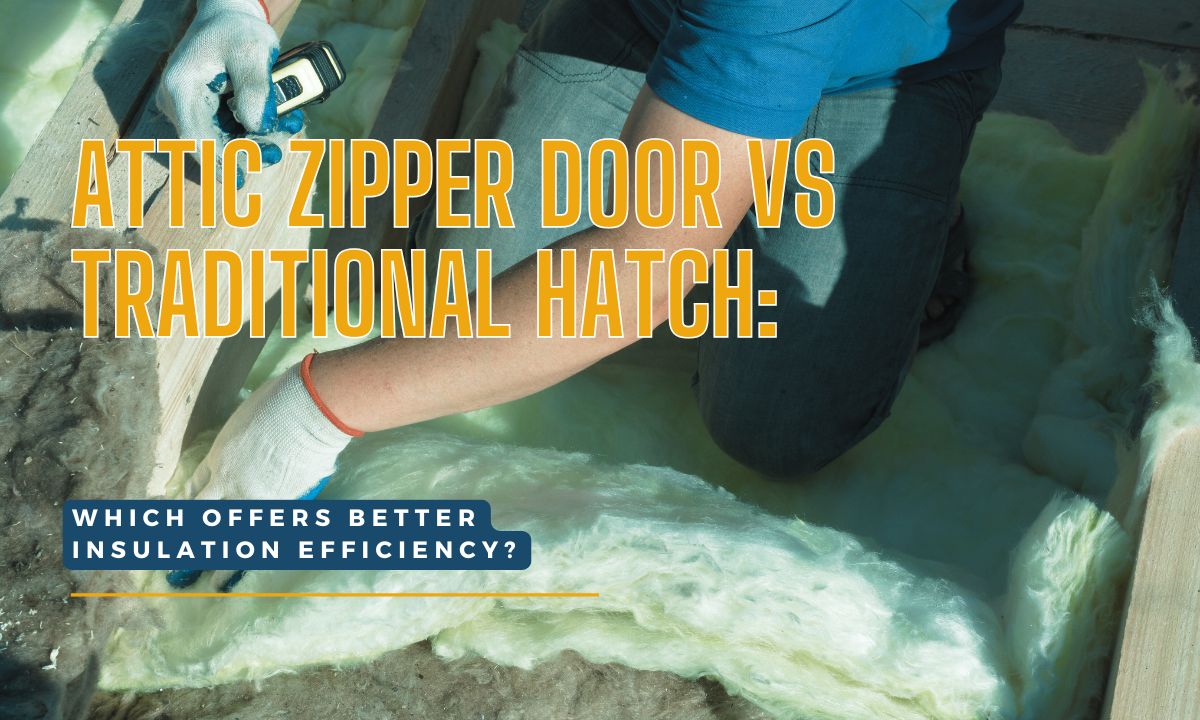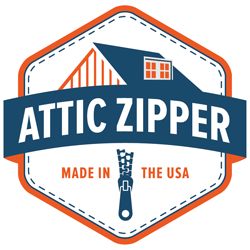
08 Nov Attic Zipper Door vs Traditional Hatch: Which Offers Better Insulation Efficiency?
In the world of home energy efficiency, few solutions tackle energy loss as effectively as sealing attic access points. One of the most significant energy leaks in homes arises from poorly insulated attic hatches. This article will compare the Attic Zipper Door to the traditional attic hatch, diving into their insulation efficiency, ease of installation, and overall value for homeowners. If you’re looking to improve home comfort, save on energy bills, and reduce HVAC wear, an attic access solution like the Attic Zipper may be the perfect fit.
Understanding the Role of Attic Insulation in Energy Efficiency
Homeowners often underestimate the impact of attic insulation on their energy bills. Properly insulated attic access points prevent energy loss by stopping conditioned air from escaping. The right attic access solution not only ensures an energy-efficient home but also increases overall comfort and HVAC system lifespan.
What is a Traditional Attic Hatch?
Overview of Traditional Attic Hatch Features
A traditional attic hatch is usually a simple access point, often a plywood or similar cover, used to enter the attic. This hatch is not typically airtight and rarely insulated, making it a prime source of energy loss in the average home.
Common Insulation Challenges
The main issue with traditional hatches is that they lack proper insulation and sealing. Over time, gaps around the hatch can expand, allowing drafts and reducing energy efficiency. The thin covering offers minimal protection from extreme temperatures, leading to increased heating and cooling costs.
What is an Attic Zipper Door?
Overview of the Attic Zipper Door
The Attic Zipper Door is an innovative attic hatch cover designed to seal attic entryways more effectively than traditional options. Made from reflective bubble insulation and equipped with a zipper closure, it provides an airtight barrier that blocks drafts and keeps conditioned air where it belongs.
How It Improves Insulation Efficiency
The Attic Zipper features multiple layers of insulation that help reduce air leakage and energy loss. This design means homeowners save on energy costs and prevent unnecessary HVAC cycles, lowering equipment wear and extending its lifespan.
The Importance of Sealing Attic Entry Points
When attic hatches remain unsealed, conditioned air from the living space leaks into the attic. This loss puts extra strain on HVAC systems and leads to higher energy costs. The right attic cover can block these leaks, ensuring a stable indoor environment.
Energy Loss Through Attic Doors and Hatches
Why Attic Entries are Prone to Energy Loss
Because hot air rises, attic hatches are natural points of energy loss, especially if they aren’t sealed properly. Without insulation, the hatch becomes a thermal bridge, conducting cold air down during winter and allowing hot attic air to seep in during summer.
Data on Energy Savings with Effective Insulation
Studies show that proper attic sealing can save homeowners over 10% on monthly energy bills. The Attic Zipper door, for instance, has been known to achieve this level of savings by blocking air leaks and preventing conditioned air from escaping.
Comparing Insulation Efficiency: Attic Zipper Door vs Traditional Hatch
Insulation Materials and Effectiveness
Traditional hatches typically lack insulation, while the Attic Zipper Door incorporates reflective bubble insulation to create a thermal barrier. This material reflects heat and prevents energy transfer, making it far more effective.
Airtight Seals and Reduction of Drafts
The Attic Zipper’s zipper mechanism ensures a tight seal, unlike a standard hatch. This feature minimizes drafts, helping to stabilize temperatures throughout the home.
Durability and Longevity
The Attic Zipper is made from robust materials designed to withstand temperature fluctuations and daily wear, whereas traditional hatches often degrade and become less effective over time. This longevity makes it a cost-effective choice in the long run.
Ease of Installation
Installation Process of a Traditional Hatch
Installing a traditional hatch is usually simple but may require additional insulation and sealing materials to prevent energy loss. This often requires professional help, increasing installation costs.
Attic Zipper’s DIY-Friendly Installation Process
The Attic Zipper is specifically designed for easy DIY installation. Homeowners can attach it in minutes using a slap stapler and adhesive, making it a convenient option for anyone looking to boost their home’s energy efficiency without needing professional assistance.
Maintenance and Upkeep
Once installed, the Attic Zipper requires minimal upkeep, as its durable material can withstand regular use. Traditional hatches, however, may need periodic resealing or replacement to maintain effectiveness.
Cost Analysis: Attic Zipper Door vs Traditional Hatch
Initial Investment
While the Attic Zipper may have a higher upfront cost than traditional hatches, its superior insulation and energy savings quickly offset the price.
Return on Investment (ROI) Over Time
The savings on energy bills alone allow the Attic Zipper to pay for itself in under a year. Over time, the Attic Zipper continues to save homeowners money, making it a smart long-term investment.
Attic Zipper Door’s Additional Benefits
Improved HVAC Efficiency
By reducing the frequency of HVAC cycles, the Attic Zipper lowers wear on the system, helping to extend its life and maintain optimal performance.
Bug Prevention
The tight seal created by the Attic Zipper blocks bugs and other pests from entering the home through the attic, offering a cleaner, more comfortable indoor environment.
Enhanced Indoor Comfort
With the Attic Zipper, drafts are virtually eliminated, creating a more consistent indoor temperature and enhancing overall comfort for residents.
Customer Reviews and Testimonials
Many users report substantial improvements in energy savings and comfort after installing the Attic Zipper. HVAC professionals, insulation experts, and homeowners alike praise the product for its ease of installation and effectiveness.
Why Attic Zipper is the Superior Choice for Most Homeowners
With its insulation efficiency, ease of use, durability, and low maintenance, the Attic Zipper offers superior performance over traditional attic hatches. It’s a worthwhile investment for anyone looking to make their home more energy-efficient.
Conclusion
When comparing the Attic Zipper Door to a traditional attic hatch, the choice is clear. The Attic Zipper offers a robust, airtight solution that saves homeowners money, reduces energy loss, and improves home comfort. This innovative product stands as a modern solution to an age-old problem, helping homeowners achieve their energy efficiency goals without sacrificing attic accessibility.
Frequently Asked Questions (FAQs)
- What makes the Attic Zipper Door more energy-efficient than a traditional hatch?
- The Attic Zipper Door provides a sealed, insulated barrier that blocks drafts and prevents conditioned air from escaping, unlike traditional hatches that often have minimal insulation.
- Is the Attic Zipper Door easy to install?
- Yes, the Attic Zipper Door is designed for DIY installation. It can be set up in minutes using basic tools, making it accessible for homeowners.
- How much can I save on energy bills with an Attic Zipper Door?
- Homeowners typically save over 10% on their monthly energy bills with the Attic Zipper, thanks to its efficient insulation properties.
- Can I still access my attic with an Attic Zipper Door?
- Absolutely! The zipper feature allows easy access to the attic while maintaining an airtight seal when closed.
- Does the Attic Zipper Door require any maintenance?
- The Attic Zipper Door is made from durable materials and requires minimal maintenance. Periodic checks to ensure the seal is intact are recommended.



